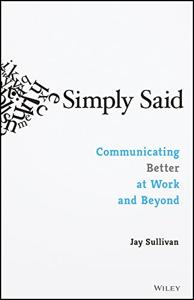
Want to learn the ideas in Simply Said better than ever? Read the world’s #1 book summary of Simply Said by Jay Sullivan here.
Read a brief 1-Page Summary or watch video summaries curated by our expert team. Note: this book guide is not affiliated with or endorsed by the publisher or author, and we always encourage you to purchase and read the full book.
Video Summaries of Simply Said
We’ve scoured the Internet for the very best videos on Simply Said, from high-quality videos summaries to interviews or commentary by Jay Sullivan.
1-Page Summary of Simply Said
Focus on Your Audience
People tend to focus on themselves, which interferes with communicating with others. To get people to understand, appreciate and approve of your ideas, you must care about them. This means focusing on what they want and need rather than yourself. If you focus on others instead of yourself, then you will be a great communicator.
Owning Your Content
Businesses need to communicate with their employees, customers, and other stakeholders. When communicating with these groups, it’s important to be specific about your message. Be clear about the main points you want to get across—your essential content. Deliver your core thoughts clearly and succinctly. Understand what you’re trying to say before saying it because many speakers don’t know exactly what they’re trying to convey when they speak in public or give a presentation in front of others. Keep your message short and simple without using jargon that might confuse people who aren’t familiar with business lingo.
How You Say It
People communicate with stories. Every story needs a beginning, middle and end. It’s important to be natural when telling a story because if you’re not, it will come across as rehearsed. You need to know your opening and closing lines in advance so that they sound spontaneous when you tell the story. If you can’t tell an engaging story, don’t try; instead use analogies or metaphors to make your point clear. For example, one person had trouble conveying her message about media interviews during training exercises using stories alone so she used an analogy of baseball games and closers to explain her point more clearly.
Persuasion involves having a clear message and an organized structure. You must also know your audience’s concerns and have a distinct purpose. If you want to give information, follow the advice of Peter Drucker: ”Tell them what you’re going to tell them.’ ‘ Tell them what you’ve got.’ ‘ Tell them what you’ve just told them.”
The way you communicate is as important as the content. If you’re presenting, don’t say “I’m here to give a presentation on X.” Instead, say “I’m here to talk about X.” Don’t refer to physical slides (“On that last slide…”), but instead use phrases like “A moment ago we discussed…”.
Verbal Communication Skills
To be a good speaker, imagine that you’re speaking to one person. Speak directly to the audience and pay attention to them. To do this, use eye contact, your voice tone and body language. You should avoid scanning the crowd while making eye contact because it will make you look distracted. Some people might not be paying attention or they could even be on their phones or talking with friends. In order to hold their focus, establish eye contact with a single audience member while delivering one complete sentence before moving onto another person in the crowd.
Speak with a variety of vocal inflections. Pause for effect occasionally. Use silence to demonstrate your confidence in the material and create suspense in your audience. Smile when you speak, as it will make you come across more warmly and engagingly than if you don’t smile at all. When standing before an audience, keep your hands apart rather than folded together or crossed over one another because that makes it easier for gestures to occur naturally during speech which helps tell the story better.
Communication is a two-way street. You must listen to others as much as you speak, and not just speak at them but actually hear what they have to say. To connect with people, learn about their values and priorities by listening carefully to what they tell you. Make sure your body language conveys that you are fully attentive when communicating with others; taking notes shows respect for the other person’s ideas.





